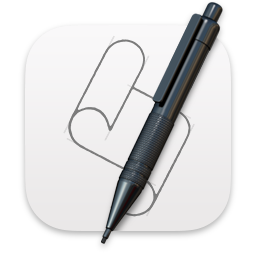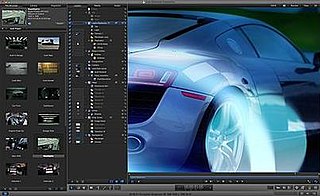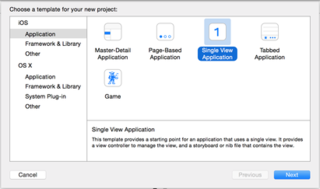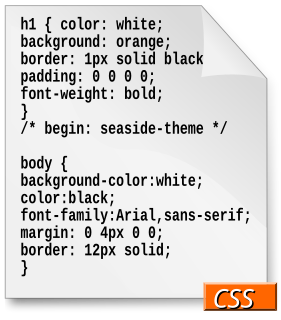
HyperCard is a software application and development kit for Apple Macintosh and Apple IIGS computers. It is among the first successful hypermedia systems predating the World Wide Web.
Cocoa is Apple's native object-oriented application programming interface (API) for its desktop operating system macOS.

AppleScript is a scripting language created by Apple Inc. that facilitates automated control over scriptable Mac applications. First introduced in System 7, it is currently included in all versions of macOS as part of a package of system automation tools. The term "AppleScript" may refer to the language itself, to an individual script written in the language, or, informally, to the macOS Open Scripting Architecture that underlies the language.

Motion is a software application produced by Apple Inc. for their macOS operating system. It is used to create and edit motion graphics, titling for video production and film production, and 2D and 3D compositing for visual effects.
In Apple's macOS operating system, Quartz is the Quartz 2D and Quartz Compositor part of the Core Graphics framework. Quartz includes both a 2D renderer in Core Graphics and the composition engine that sends instructions to the graphics card. Because of this vertical nature, Quartz is often synonymous with Core Graphics.
Kaleida Labs formed in 1991 to produce the multimedia cross-platform Kaleida Media Player and the object oriented scripting language ScriptX that was used to program its behavior. The system was aimed at the production of interactive CD ROM titles, an area of major effort in the early 1990s. When the system was delivered in 1994, it had relatively high system requirements and memory footprint, and lacked a native PowerPC version on the Mac platform. Around the same time, rapid changes in the market, especially the expansion of the World Wide Web and the Java programming language, pushed the interactive CD market into a niche role. The Kaleida platform failed to gain significant traction and the company was closed in 1996.
MacApp was Apple Computer's primary object oriented application framework for the classic Mac OS for much of the 1990s. First released in 1985, it is arguably the first such system to be widely used, notably on a microcomputer platform. Microsoft's MFC and Borland's OWL were both based directly on MacApp concepts.
JavaScript OSA,, is a freeware inter-process communication scripting language for the Macintosh computer.
Core Foundation is a C application programming interface (API) in macOS & iOS, and is a mix of low-level routines and wrapper functions. Apple releases most of it as an open-source project called CFLite that can be used to write cross-platform applications for macOS, Linux, and Windows; a third-party open-source implementation called OpenCFLite also exists. Most Core Foundation routines follow a certain naming convention that deal with opaque objects, for example CFDictionaryRef for functions whose names begin with CFDictionary, and these objects are often reference counted (manually) through CFRetain and CFRelease. Internally, Core Foundation forms the base of the types in the Objective-C standard library as well.
Core Data is an object graph and persistence framework provided by Apple in the macOS and iOS operating systems. It was introduced in Mac OS X 10.4 Tiger and iOS with iPhone SDK 3.0. It allows data organized by the relational entity–attribute model to be serialized into XML, binary, or SQLite stores. The data can be manipulated using higher level objects representing entities and their relationships. Core Data manages the serialized version, providing object lifecycle and object graph management, including persistence. Core Data interfaces directly with SQLite, insulating the developer from the underlying SQL.

Motion graphics are pieces of digital footage or animation which create the illusion of motion or rotation, and are usually combined with audio for use in multimedia projects. Motion graphics are usually displayed via electronic media technology, but may also be displayed via manual powered technology. The term distinguishes still graphics from those with a transforming appearance over time, without over-specifying the form. While any form of experimental or abstract animation can be called motion graphics, the term typically more explicitly refers to the commercial application of animation and effects to video, film, TV, and interactive applications.
Apple Dylan was the implementation of the Dylan programming language produced by Apple Computer. Apple Dylan was originally developed as the toolbox and application language for the Apple Newton, but later released as a stand-alone development environment for the classic Mac OS, only to be abandoned shortly thereafter.

3D computer graphics or three-dimensional computer graphics, are graphics that use a three-dimensional representation of geometric data that is stored in the computer for the purposes of performing calculations and rendering 2D images. Such images may be stored for viewing later or displayed in real-time.
Core Text is a Core Foundation style API in macOS, first introduced in Mac OS X 10.4 Tiger, made public in Mac OS X 10.5 Leopard, and introduced for the iPad with iPhone SDK 3.2. Exposing a C API, it replaces the text rendering abilities of the now-deprecated QuickDraw and ATSUI frameworks in previous versions of Mac OS X. According to Apple, Core Text is "designed for high performance and ease of use" and its layout API is "simple, consistent, and tightly integrated with Core Foundation, Core Graphics, and Cocoa."

The iOS SDK is a software development kit developed by Apple Inc. The kit allows for the development of mobile apps on Apple's iOS operating system.
Objective-C is a general-purpose, object-oriented programming language that adds Smalltalk-style messaging to the C programming language. It was the main programming language supported by Apple for the macOS and iOS operating systems, and their respective application programming interfaces (APIs) Cocoa and Cocoa Touch until the introduction of Swift.
The programming language Objective-C was originally developed in the early 1980s. It was selected as the main language used by NeXT for its NeXTSTEP operating system, from which macOS and iOS are derived. Portable Objective-C programs that do not use the Cocoa or Cocoa Touch libraries, or those using parts that may be ported or reimplemented for other systems, can also be compiled for any system supported by GNU Compiler Collection (GCC) or Clang.
Swift is a general-purpose, multi-paradigm, compiled programming language developed by Apple Inc. for iOS, macOS, watchOS, tvOS, Linux, and z/OS. Swift is designed to work with Apple's Cocoa and Cocoa Touch frameworks and the large body of existing Objective-C code written for Apple products. It is built with the open source LLVM compiler framework and has been included in Xcode since version 6, released in 2014. On Apple platforms, it uses the Objective-C runtime library which allows C, Objective-C, C++ and Swift code to run within one program.
SceneKit, sometimes rendered Scene Kit, is a 3D graphics application programming interface (API) for Apple Inc. platforms written in Objective-C. It is a high-level framework designed to provide an easy-to-use layer over the lower level APIs like OpenGL and Metal. SceneKit maintains an object based scene graph, along with a physics engine, particle system, and links to Core Animation and other frameworks to easily animate that display. SceneKit views can be mixed with other views, for instance, allowing a SpriteKit 2D display to be mapped onto the surface of an object in SceneKit, or a UIBezierPath from Core Graphics to define the geometry of a SceneKit object. SceneKit also supports import and export of 3D scenes using the COLLADA format. SceneKit was first released for macOS in 2012, and iOS in 2014.








